Thanks to Mike Gartland and John Morrow, The Kirby Effect is offering Mike’s “A Failure To Communicate” series from The Jack Kirby Collector. – Rand
Part One was first published in TwoMorrows’ October 1998 Jack Kirby Collector 21.
This started out simply enough; I was reading FF Annual #3’s “Bedlam At The Baxter Building!” when I noticed on page 2 that Doctor Doom wasn’t using his hands to operate his machine. The owner of the original art was nice enough to send me a copy and upon viewing, my suspicions were confirmed. Kirby’s margin notes had Doom still recovering from his battle with the Thing in FF #40’s “The Battle Of The Baxter Building!”, so he couldn’t fully use his hands yet. To Kirby, this was the reason Doom used a machine to attempt to ruin the wedding. Lee, however, ignored this totally in favor of high drama, thereby changing Kirby’s reasoning for Doom’s motive. Thus Lee has Doom using the machine as a grand gesture of revenge and contempt; Kirby had him use it because he couldn’t attack the FF personally.
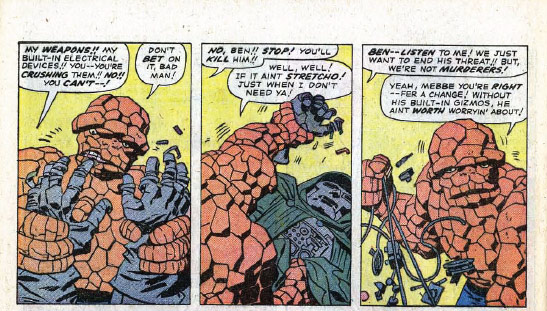
detail, “The Battle Of The Baxter Building!”, page 20,
first publication, Marvel Comics’ Fantastic Four 40, July 1965
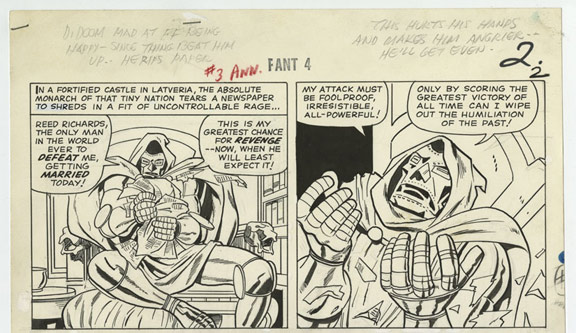
Original art detail, “Bedlam At The Baxter Building!” page 2,
first publication in Marvel Comics’ Fantastic Four Annual 3,1965.
There are many examples of art and dialogue not meshing correctly in the Kirby/Lee books. Some may cite the “Marvel Method” of producing the books as the reason. There are small examples in the early years, becoming more noticeable in the books produced between ’64-’70, books where Kirby was pretty much plotting the stories on his own. This also helps to explain why there are so many more Kirby margin notes on the art from this period. Once Kirby had his story established on paper, he sent it to Lee, who as editor and dialogue writer would keep what he considered essential (or couldn’t change because the accompanying visuals were too obvious to alter through dialogue) and change what he wished for reasons of drama, continuity, or whatever his intention was at the time.
With this in mind, we begin a series of articles showcasing stories and/or separate examples of art and words not mixing correctly; or one man’s view of the story differing from the other’s. We are not attempting to prove that either man was right or wrong, or deserved more credit than the other; it is simply an ongoing dissertation of facts that will be presented for you, the reader, to draw your own conclusions from. Of course, we hope you enjoy it as well.
Before going further, I would advise you to read four pages from “The Reason Why!” by Kirby/Lee. First read it using Jack’s margin notes only, as this is how Kirby intended the story to go and how Lee received it before making changes. Then go over the story again, this time reading Lee’s dialogue. Then if you wish, go back to this article where my opinions are. I want the reader to draw their own conclusions before reading mine.
- “The Reason Why!” page 2
- “The Reason Why!” page 3
- “The Reason Why!” page 4
- “The Reason Why!” page 5
That Would Be Inhuman!
Jack’s Inhumans pretty much seemed to be one of his evolving creations. It began with one character, Medusa, eventually segueing into the Inhumans about a year later, finally leading to their origins about two years later. Although Jack did give a brief one page semi-origin in FF #46’s “Those Who Would Destroy Us!”, he would eventually expand on this to give a more detailed origin after the creation of one of his other races—the Kree—connecting the two races through story. Jack introduced his take on the Inhumans in the back-up story section of Thor (although there’s evidence to suggest that Jack originally did one long story for the first issue of a proposed 1960s Inhumans comic, and when it was shelved, the story was split up to make these Thor back-ups). The story printed here was originally published in Thor #147 and is part of Jack’s multi-part Inhumans origin story.

“Those Who Would Destroy Us!”, page 18,
first publication, Marvel Comics’ Fantastic Four 46, January 1966
As his margin notes bear out, Jack intended for the Inhumans to be already fully aware of their origins. They know that they are advanced humans, descended from the Kree (through technology). They knew what the Sentry was and have dealt with it before. The Kree experiment that changed humans began to go awry when the advanced race separated themselves, rather than develop along with the non-advanced races. They also began conducting dangerous, forbidden experiments. This brings the Sentry, who comes to warn them of the risk and danger, and attempts to halt it, but he arrives too late. Upon this realization, the Sentry warns them that they will be shunned by their fellow man; in essence they are no longer human but have made themselves In-human. As far as the Sentry is concerned, this was a failed Kree experiment.
Lee, for whatever reason, changes the basics of the story. The Sentry is unknown to the Inhumans; it is he who informs them of their link to the Kree for the first time. It was the Kree who separated the race from the other races. The Sentry is there to observe for the Kree. He witnesses the results of the advanced race’s experiments and is pleased; dubbing them Inhumans, he considers the Kree experiment to be successful.
Thus for the sake of drama (or vanity?), Lee turns a tale of foreboding into a success for the greater glory of the advancement of mankind. Where Kirby’s Sentry warns, Lee’s encourages—two takes on one story. Was it that important to change the meaning of Jack’s story simply for the sake of optimistic drama? You be the judge. If anything, it clearly shows two people “collaborating” in different directions!


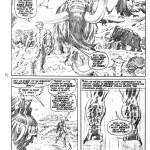
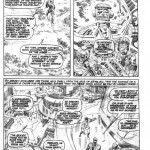
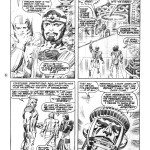
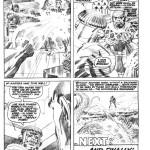
My biggest problem with Lee’s scripting over Jack’s work on the FF was his insistence on using dialogue to describe the action in the panel. It wasn’t enough for Kirby to draw a punch, Lee had to describe the damn thing. You could cut about half of Lee’s exposition without hurting the story at all.
He didn’t do this as much in Thor, Spider-Man or Dr. Strange– I wonder why?
Part of it is, as Mike points out, Lee in addition to being overly chatty is contradicting the pictures, rewriting Kirby’s story, and in such a way Kirby’s intent is turned upside down. It’s literally a B&W reversal of the story as Kirby told it.
Fantastic to see this here. What would be even better would be if Mike could surprise us with a new installment.
This series of articles was a real eye opener for me. I’d never been much of a fan of the Marvel material. Reading the ’60s Marvel stuff for the first time in the early ’70s along side Kirby’s Fourth World it seemed unfocused, confused. Mike’s articles made it easy to understand why.
John’s only been asking for the last ten years to do a book; but since I first wrote these the internet exploded with many writing about the working relationship btw Kirby & Lee (and with a good deal of arguing too). Who knows, someday!
Great piece; as a comic book writer and Kirby lover, this is fantastic material.
Very much appreciated, Thanks!
I just added the one-page origin from “Those Who Would Destroy Us!” (page 18,
first publication, Fantastic Four 46, January 1966) to the article.
Excellent addition Rand. As informative and important as these articles are the addition of more illustrations. and the ability to look at them in larger size is a plus.
This stuff is great! Thanks. It would be wonderful to have a master list of all the stories where this took place with the differences between margin notes and final work.
All evidence suggests the failure to communicate dated back to the earliest days at Marvel. Things are easier to document based on hard evidence like Kirby’s border notes and the published stories as rewritten by Lee. Earlier problems are evident in the fact many cartoonists from the 1958-1965 era have said Lee demanded many pages redrawn to suit his rewrites. Joe Orlando told Mark Evanier he had to commonly redraw five to ten pages for every story he turned in. Jack Kirby had his version of Spiderman rejected completely when Steve Ditko pointed out to Lee the Kirby version resembled the Simon & Kirby character THE FLY. Lee has said the Kirby story was rejected because Kirby’s Spiderman was too heroic looking, but that makes little sense because in the early ’60s Kirby’s figures were often rail thin. The nascent Reed Richards, Don Blake, and Bruce Banner were all pencil necked geeks. Lee’s brother Larry Lieber saw Kirby emerge from a meeting with Lee so frustrated he tore a HULK story in half and tossed it in a waste basket.
The wonderful thing about the border notes is they are clear documentation. We know that the very last Fantastic Four story Kirby created was heavily rewritten by Lee who once again turned the clear intent of Kirby story on it’s head.
A Herculean task. At one time when the originals were being released many pages were still intact as whole stories and that was the optimum time. Even when I had the opportunity, the task was too time consuming for any one individual; especially concerning the stories Jack was laying out for others to draw & dialog where his notes are even more descriptive.
I just loved the serialization of this work when it first appeared in The Jack Kirby Collector, and I second the call for a book that collects and expands on this work/this analysis. It is out-standing. I recall nodding my head again and again at things that I had noticed as a kid, first reading these stories, and now had them pointed out to me again.
Pingback: Crouching Kirby, Hidden Magneto | Kirby Dynamics